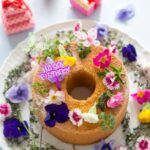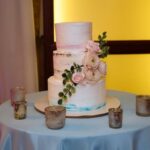Are you looking to learn how to decorate a cake with royal icing recipe? Royal icing is a versatile and classic decorating medium that can take your cakes to the next level.
It is made from powdered sugar, egg whites, and flavorings, resulting in a smooth and hard finish that is perfect for intricate designs and decorations. Whether you are a beginner or an experienced baker, mastering the art of decorating with royal icing can elevate your creations and impress your friends and family.
Royal icing is popular among decorators for its versatility and ability to create detailed designs on cakes. With the right tools and techniques, you can create beautiful flowers, intricate lace patterns, and elegant piped borders.
Its smooth consistency allows for clean lines and precise details, making it ideal for both simple and elaborate cake designs. In this article, we will guide you through the process of making royal icing from scratch, as well as provide tips and tricks for achieving the perfect consistency and color for your decorations.
Before diving into the world of royal icing decoration, it’s important to gather all the necessary tools and ingredients. From piping bags to parchment paper, having the right equipment will make the decorating process much smoother.
Additionally, understanding the different consistencies of royal icing – such as flooding and piping – will be key to creating flawless decorations on your cakes. So grab your baking supplies and get ready to transform your cakes into works of art with our step-by-step guide on how to decorate a cake with royal icing recipe.
Necessary Tools and Ingredients for Royal Icing Decoration
Tools for Decorating With Royal Icing
When it comes to decorating a cake with royal icing, having the right tools is essential. Some of the necessary tools include piping bags, piping tips of various sizes and shapes, offset spatula for smoothing icing, toothpicks for details, and a turntable for easy access to all sides of the cake. Investing in quality tools will make your decorating process smoother and more professional-looking.
Ingredients for Making Royal Icing
To create the perfect royal icing for decorating your cake, you will need just a few simple ingredients. These typically include powdered sugar (also known as confectioners’ sugar), meringue powder or egg whites, water, and flavor extracts (such as vanilla or almond). These ingredients are easy to find in most grocery stores and are relatively inexpensive. With these basic ingredients, you can whip up a batch of royal icing that is perfect for decorating cakes.
Coloring and Flavoring Options
Once you have mastered the basics of making royal icing, you can experiment with coloring and flavoring options to add your own personal touch to your decorations. Gel food coloring works best with royal icing since it won’t affect the consistency of the icing.
You can also add flavored extracts like strawberry, lemon, or even coconut to give your decorations an extra layer of taste. By playing around with different colors and flavors, you can let your creativity shine through in your beautifully decorated cakes.
Step-by-Step Guide on How to Make Royal Icing From Scratch
Royal icing is a versatile and classic icing that is perfect for decorating cakes, cookies, and other sweet treats. Its smooth finish and ability to harden make it ideal for creating intricate designs and decorations on baked goods. Making royal icing from scratch is not as intimidating as it may seem, and with the right tools and ingredients, you can easily master this technique.
To make royal icing from scratch, you will need some basic ingredients such as powdered sugar, egg whites or meringue powder, and water. Start by sifting the powdered sugar to remove any lumps and ensure a smooth consistency. In a clean mixing bowl, combine the egg whites or meringue powder with water until frothy. Gradually add in the sifted powdered sugar while mixing on low speed until the icing reaches your desired consistency.
One important tip when making royal icing is to pay attention to the consistency. The icing should be thick enough to hold its shape when piped but thin enough to flow smoothly when flooding cookies or cakes. If the icing is too thick, add a few drops of water at a time until you reach the desired thickness.
On the other hand, if the icing is too thin, add more powdered sugar until it thickens up. With practice and patience, you’ll soon get the hang of how to adjust the consistency of your royal icing for different decorating techniques.
Tips and Tricks for Consistency and Color of Royal Icing
When it comes to decorating a cake with royal icing, achieving the perfect consistency and color is crucial for stunning results. Royal icing is known for its smooth finish and ability to hold intricate designs, making it a popular choice for decorative purposes. Here are some tips and tricks to help you master the consistency and color of your royal icing:
Consistency Is Key
One of the most important aspects of working with royal icing is getting the right consistency. If the icing is too thick, it will be difficult to pipe or spread smoothly on the cake. On the other hand, if the icing is too runny, it will not hold its shape when decorating.
To achieve the perfect consistency, you can adjust the amount of water in your royal icing recipe. Add water little by little until you reach a smooth and flowing consistency that holds its shape when piped.
Playing With Color
Royal icing can be colored in a variety of ways to create beautifully decorated cakes. You can use gel food coloring to achieve vibrant and consistent colors in your icing. Start with a small amount of food coloring and gradually add more until you reach your desired shade.
Remember that royal icing tends to darken as it dries, so keep this in mind when adjusting the color intensity. For a more subtle effect, you can also use natural food coloring options like beet powder or matcha powder.
Adding Flavor
Aside from achieving the right consistency and color, adding flavor to your royal icing can enhance the overall taste of your decorated cake. You can incorporate flavored extracts like vanilla, almond, or lemon into your royal icing recipe for an extra layer of deliciousness.
Just be sure to start with a small amount of extract and adjust according to your taste preference. Consider complementing the flavor of your cake with a complementary flavor in your royal icing for a perfectly balanced treat.
Preparing Your Cake for Royal Icing Decoration
When it comes to decorating a cake with royal icing, preparation is key to achieving a flawless finish. One of the essential steps before applying royal icing is crumb coating and leveling your cake. This ensures that the icing adheres smoothly to the surface and creates a professional-looking result. Here is a step-by-step guide on how to prepare your cake for royal icing decoration:
- Leveling the Cake: Start by ensuring that your cake layers are level. You can use a serrated knife or a cake leveler to trim any domed tops and create an even surface.
- Crumb Coating: The crumb coat is a thin layer of frosting that seals in any loose crumbs on the cake surface. This will prevent crumbs from mixing into your final layer of royal icing. Apply a thin layer of buttercream or ganache around the entire cake before chilling it in the refrigerator for about 15 minutes to set.
- Final Coat: Once the crumb coat has set, you can apply your final layer of royal icing for decoration. The smooth surface created by the crumb coat will help the royal icing adhere evenly and flawlessly to the cake.
Properly leveling and crumb coating your cake will serve as the foundation for successful royal icing decoration. Taking the time to prep your cake in this way will ensure that your final design looks polished and professional.
Remember, patience is key when preparing your cake for royal icing decoration. Take your time during each step, from leveling to crumb coating, as these processes are crucial in achieving a beautifully decorated cake using royal icing recipe.
Techniques for Decorating With Royal Icing
Royal icing is a versatile and classic choice for decorating cakes due to its smooth finish and ability to hold intricate designs. Piping is one of the most common techniques used with royal icing, allowing decorators to create delicate borders, lettering, flowers, and other detailed decorations.
To pipe with royal icing, fill a piping bag fitted with a small tip with the desired consistency of icing. Hold the bag at a 45-degree angle from the surface of the cake and apply gentle pressure to create your design.
Another popular technique for decorating with royal icing is flooding, which involves filling in larger areas or creating a smooth base for detailed piping work. To flood with royal icing, start by outlining the area you want to fill with a thicker consistency of icing using piping bags or squeeze bottles.
Then, fill in the outlined area with a thinner consistency of icing called flood icing. Use a toothpick or small spatula to spread and blend the flood icing evenly before it sets.
Marbling is a creative technique that adds depth and texture to royal icing decorations. To marble royal icing, start by preparing separate batches of colored icings in contrasting shades. Dollop spoonfuls of each color onto the cake surface, then use a toothpick or skewer to swirl and blend them together in various patterns. This technique works well for achieving marble-like effects on backgrounds or creating unique textures on flowers and other elements of your cake design.
| Royal Icing Technique | Description |
|---|---|
| Piping | Creating intricate designs such as borders, lettering, flowers using piping bags |
| Flooding | Filling in larger areas or creating smooth bases for detailed work using different consistencies of icing |
| Marbling | Adding depth and texture through swirling different colors together in various patterns |
Advanced Royal Icing Decoration Ideas
Royal icing is a versatile and durable decorating medium that allows for intricate designs on cakes. Once you have mastered the basics of royal icing decoration, you can move on to more advanced techniques such as creating delicate roses, elegant ruffles, and intricate lace patterns. These advanced decoration ideas will take your cake decorating skills to the next level and wow your friends and family.
To create stunning royal icing roses, start by piping a small cone shape with a piping bag fitted with a petal tip. Then, pipe overlapping petals around the cone shape, gradually increasing in size to form layers of petals. Use a gentle touch to create realistic curves and folds in the petals. You can make roses in different sizes and colors to add variety to your cake decorations.
For ruffles, use a ribbon or leaf tip on your piping bag to create long, wave-like strips of royal icing along the edges of your cake tiers. Start at the bottom of the tier and work your way up, layering the ruffles slightly overlapping each other. Ruffles add texture and movement to your cake design, giving it an elegant and whimsical look.
Creating lace patterns with royal icing involves using intricate piping techniques to mimic the delicate designs of real lace fabric. You can use a fine round tip or a lace tip to pipe intricate patterns onto your cake tiers. Practice different designs on parchment paper before transferring them onto your cake for precision. Lace decorations add a touch of sophistication and vintage charm to any cake design.
| Advanced Royal Icing Decoration Ideas | Roses, Ruffles, and Lace |
|---|---|
| Royal Icing Roses | Create realistic curves and folds in the petals with a gentle touch |
| Royal Icing Ruffles | Add texture and movement by layering wave-like strips along cake edges |
| Royal Icing Lace Patterns | Mimic delicate lace designs with intricate piped patterns for a vintage charm |
Troubleshooting Common Royal Icing Decoration Issues
Royal icing is a versatile and popular choice for decorating cakes due to its smooth finish and ability to create intricate designs. However, like any decorating technique, there are common issues that can arise when working with royal icing. Some of the most common problems include cracks, bubbles, and splotchy colors. Fortunately, with a few tips and tricks, you can troubleshoot these issues and achieve professional-looking results on your cakes.
One of the most frustrating issues that can occur when decorating a cake with royal icing is cracks in the icing. Cracks often form when the royal icing dries too quickly or when it is applied too thickly.
To prevent cracks, make sure to let each layer of icing dry completely before adding another layer. You can also try thinning out your royal icing slightly with water to create a smoother consistency that is less likely to crack as it dries.
Another common problem when working with royal icing is the formation of bubbles in the icing. Bubbles can occur when air gets trapped in the piping bag or when the icing is overmixed. To prevent bubbles, be sure to tap the filled piping bag on the counter to release any trapped air before piping. Additionally, avoid overmixing your royal icing and stir it gently to maintain a smooth consistency without introducing excess air into the mixture.
Finally, splotchy colors can be a frustrating issue when decorating a cake with royal icing. This problem often occurs when the coloring agents are not fully incorporated into the icing or when multiple layers of colored icing are applied unevenly.
To ensure vibrant and even colors on your cake, take extra care when mixing your food coloring into the royal icing, making sure to mix it thoroughly until no streaks remain. Additionally, apply multiple thin layers of colored royal icing instead of one thick layer to ensure an even distribution of color across the surface of your cake.
Conclusion
In conclusion, mastering the art of decorating a cake with royal icing recipe can truly elevate your baking skills and impress your friends and family. By following the step-by-step guide provided in this article, you can learn how to make royal icing from scratch, achieve the perfect consistency and color, and explore various techniques like piping, flooding, and marbling.
With practice and patience, you will be able to create beautiful designs such as roses, ruffles, and lace to adorn your cakes.
One important aspect that should not be overlooked is preparing your cake for royal icing decoration. Crumb coating and leveling are essential steps to ensure a smooth surface for your intricate designs to shine. Additionally, learning how to troubleshoot common issues like cracks, bubbles, and splotchy colors will help you overcome any challenges that may arise during the decorating process.
Lastly, once you have finished decorating your masterpiece with royal icing, it’s important to know how to store it properly. To preserve the beauty of your creation, make sure to store decorated cakes in a cool, dry place away from direct sunlight or heat sources. Whether it’s for a special occasion or just for fun, decorating cakes with royal icing is a delightful way to unleash your creativity and showcase your baking talents.
Frequently Asked Questions
How Do You Put Royal Icing on a Cake?
Putting royal icing on a cake involves preparing the icing to the desired consistency, then using a piping bag or spatula to apply it to the cake in decorative patterns. It is important to work quickly before the icing sets.
How Do You Harden Royal Icing on a Cake?
Royal icing hardens naturally as it dries, but there are ways to speed up the process. After applying the icing to the cake, allow it to air dry in a cool, dry place with good air circulation. Alternatively, you can use a fan or gentle heat source to help set the icing faster.
How Long Does Royal Icing Last on a Cake?
The longevity of royal icing on a cake depends on various factors such as storage conditions and humidity levels. In general, properly stored cakes decorated with royal icing can last for several days at room temperature. However, it is recommended to consume them within a week for optimal freshness and taste.

Welcome to my blog about home and family. This blog is a place where I will share my thoughts, ideas, and experiences related to these important topics. I am a stay-at-home mom with two young children. I hope you enjoy reading it! and may find some helpful tips and ideas that will make your home and family life even better!





